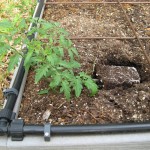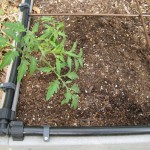No home vegetable garden is complete without a good crop of tomatoes. Tomatoes are one of the most popular, and easily grown, vegetables in the country. Once you’ve tasted a fresh picked tomato from your own garden, you’ll wonder what those bland, waxy, tasteless red orbs are that you’ve been getting from your grocery store produce section.
Tomato Plants
Tomatoes can be grown either from seed started indoors, or from transplants purchased at your local garden center. There is always a large selection of transplants available at reasonable prices come springtime and transplants are usually the easiest way to start your tomatoes. Select healthy plants that are 6 to 8 inches tall. Check to be sure that the transplants are not root bound. That is, that they don’t have a large amount of roots poking out of the bottom of the pot.
If starting your own tomato plants from seed, plant the seeds in a light, seed starter type, soil mixture, such as Miracle-Gro Seed Starter Potting Mix at least 4 to 7 weeks before they are to be planted outdoors in your garden. One week before they are to be planted, harden-off the tomato plants by placing the potted plants in your garden to gradually expose them to increased amounts of sunlight.
Varieties
Tomatoes come in all sorts of shapes, sizes, colors, and varieties. Check with your local county extension agency (see our post from March 2011) to find the varieties that are best suited for your area. Or, register in our Discussion Forum, and post a question asking which varieties are best for your specific City and State and we’ll be glad to let you know.
Planting
Tomatoes should be planted after the danger of frost has passed. Check out our recent post on determining the Last Frost Date for your area. Tomatoes do best in well-drained soil that is rich in organic matter and require at least 6 hours of sunlight per day. Raised beds are always a good choice.
An excellent way to encourage a vigorous root system on your tomato plants is to lay the plant on its side when planting.  Dig a hole that is as deep as the transplant root ball is wide. Next dig a shallow trench just below the surface to bury the transplant’s stem in. Leave the top 3 to 4 inches of the plant sticking out of the ground and pile a little bit of dirt under this part to angle it slightly upward.
Dig a hole that is as deep as the transplant root ball is wide. Next dig a shallow trench just below the surface to bury the transplant’s stem in. Leave the top 3 to 4 inches of the plant sticking out of the ground and pile a little bit of dirt under this part to angle it slightly upward. Be sure to carefully trim off any leaves that are to be buried. Within a few days the plant will be completely vertical.
Be sure to carefully trim off any leaves that are to be buried. Within a few days the plant will be completely vertical.
Care
If left to their own devices, tomatoes will grow only so tall before they fall over and grow along the ground. This encourages disease, poor fruit production, and is not an efficient use of space. Use stakes or cages to help support your tomatoes and keep them growing upright. Place the stake or cage in the ground shortly after planting to minimize possible root damage. If using stakes, they should be about 6 feet tall and the tomato plant should be loosely tied to the stake at 10 inch intervals to support the plant.
Tomatoes need about 1 to 2 inches of water per week. Make sure that you keep them from drying out and wilting. If you don’t have adequate rainfall, water them once or twice a week. Consider drip irrigation as it conserves moisture and avoids getting the plant’s foliage wet which can cause diseases.
Fertilize your plants once a week with an application of a balanced fertilizer such as Miracle-Gro Tomato Plant Food.
Enjoy your gardening and enjoy your harvest.



I love tomatoes, and a friend of mine has also told me that home grown tomatoes are much better than store bought. I think I will have to grow some of my own tomatoes if they are that much better, and this article gives me a great idea on how to do it. Thanks!
There is some great information in this article. I have a question. Can tomato plants take full sunshine in the Sonoran Desert or should they have shade part of the day? Thanks!
Tomatoes are considered a warm season crop as they do not take frost well. They should be planted in an area that receives plenty of morning sunlight, 6-8 hours of full sun, and some afternoon shade. However, high temperatures will reduce fruit quality, i.e. sunburned fruit or poorly colored fruit, and will cause the tomato flowers to drop before fruit development occurs. Arizona has quite a few varied climates, based mostly on elevation, and this determines WHEN vegetables should be planted. In the Phoenix and Chandler area for example, tomatoes should planted between February 15 and March 15. Hope this helps.
I planted some tomatoe plants in a raised box.They were getting huge,and I was pleased how beautiful things were coming along.For the last 2 weeks my plants look wilty during the day,as if there dying, and it seems when I look at them first thing in the moring they look good again.Not sure what to do if anything.Thanks.
If it’s been very hot in your area lately, the most likely cause of your tomato plants wilting is probably due to the heat. When plants wilt during the day and then recover overnight, it is their defense mechanism to protect themselves from extreme heat. Be sure to keep them evenly watered, but water only at the base of the plant, don’t water the leaves. Since you are using a raised box, make sure that the box drains well so as not to overwater. If the temperature stays very hot for an extended period of time, the tomato plants may not produce fruit right away. Keep them watered and once the weather cools off they should start to produce tomatoes again.
Love your site. Lots of beautiful pictures and information.
I have a tomato problem. I liven in CT. very hot in humid. My two little tomato plants
are growing fine. Large and bushy. I have about 10 nice size tomatoes on them but I noticed two of the upper tomatoes have what looks like the birds have been pecking on them. Long indentation on the skin and a small hole. Can anyone help me with this problem. I can send a picture if it will help.
Glad to hear you’re enjoying the site. Great to have you visit us! It sounds like it may well be birds going after your tomatoes. If your tomatoes are caged, and have already set fruit, you may want to consider wrapping a light -weight row cover fabric around the cage to keep the birds away from your tomatoes. This fabric is breathable and allows sunlight and rain to reach the plant. Sometimes just putting a few old fashioned pin-wheels in the garden to spin in the wind will keep the birds away also. Hope this helps.